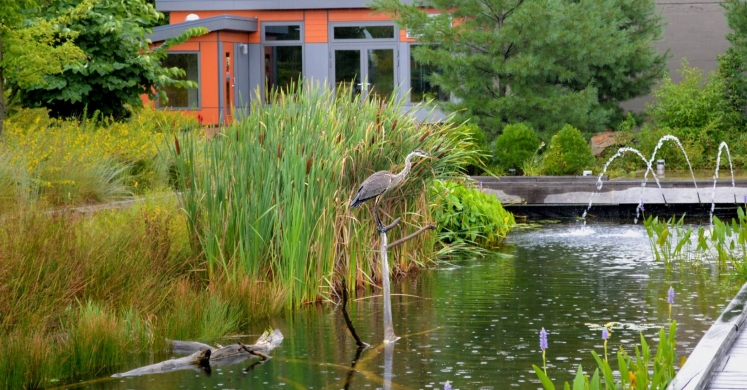Blog

#bioPGH Blog: Great Blue Heron
 A resource of Biophilia: Pittsburgh, #bioPGH is a weekly blog and social media series that aims to encourage both children and adults to reconnect with nature and enjoy what each of our distinctive seasons has to offer. From the best times to plant seasonal flora and enjoy their peak blooms, to astronomical events and creatures to keep an eye and ear out for, Phipps will keep you in the know with what’s going on in our environment!
A resource of Biophilia: Pittsburgh, #bioPGH is a weekly blog and social media series that aims to encourage both children and adults to reconnect with nature and enjoy what each of our distinctive seasons has to offer. From the best times to plant seasonal flora and enjoy their peak blooms, to astronomical events and creatures to keep an eye and ear out for, Phipps will keep you in the know with what’s going on in our environment!
Last week, Phipps staff were pleasantly surprised to find a great blue heron poaching fish from the lagoon at the Center for Sustainable Landscapes. The great blue heron (Ardea Herodias) is the largest heron in North America, and this stately bird is a common sight at the edge of a lake or pond, slowly and methodically stalking its prey.
Male and female great blue herons have similar features, characterized by slate gray and blue feathers, a white face with a sharp black eye stripe and a dagger-like, pale yellow bill. Like many herons, the great blue has powder down, a special type of down feather that disintegrates and forms a fine keratin powder, which the birds comb through their plumage to protect it from the elements. The characteristic "S" shape of the heron’s neck is due to a modification in the shape of the sixth vertebrae. This allows the heron to retract its neck, which in flight gives the appearance of a compact, slow-moving plane, croaking as it flies overhead.
In western Pennsylvania, great blue herons are typically summer residents, but may sometimes reside year round. Herons are found in a wide variety of watery habitats and while they primarily forage in water on small fish, they are also opportunistic feeders, dining on amphibians, reptiles and aquatic invertebrates. Great blue herons will also hunt terrestrially on small mammals and birds.
While great blue herons are generally solitary hunters, they are often colonial nesters, and occupy nests in “rookeries,” or breeding colonies, which can contain a few to several hundred pairs of herons. Colonial nesting is an adaptation that provides greater protection than nesting alone: more eyes make less work in defending against predators. There’s also a lower risk of nest predation for a single nest within a large colony. While adults have few predators, eggs and young herons are susceptible to attacks by bird and mammalian predators such as raptors, owls, ravens, and raccoons. If you happen upon a rookery, it’s best to keep your distance so that you don’t disturb the birds. Although adult herons usually return to nests, temporary abandonment may put eggs or chicks at risk of exposure or predation.
Great blue herons are top predators in the food web, and recent research has found that herons can affect the abundance of other species within an aquatic community. In experiments where herons were temporarily excluded from the environment, some fish species proliferated, changing the composition of the fish community. Additionally, because great blue herons are numerous, feed on a wide variety of smaller species and are found in diverse habitats, they may serve as a monitoring system for environmental pollutants, which can accumulate in top-level predators through their diet. Scientists found that toxin levels in the blood or eggs of herons serve as a proxy for the health of the environment.
Connecting to the Outdoors Tip: Now that we’re approaching migration season, there are numerous bird walks in both state and local parks around Pennsylvania. Visit Learn your Land to find a bird walk that suits your schedule in September. If you want to get up close and personal with some other heron species, visit the National Aviary. For a children's indoor heron-related activity, try making this dancing blue heron puppet.
Continue the Conversation: Share your nature discoveries with our community by posting to Twitter and Instagram with hashtag #bioPGH, and R.S.V.P. to attend our next Biophilia: Pittsburgh meeting.
Resources:
Center for Sustainable Landscapes | Phipps Conservatory and Botanical Gardens
Heron | Wikipedia.org
Great Blue Heron | Allaboutbirds.org
Great Blue Heron Contaminant Assessment | Avibirds.com
Events | Learn Your Land
Bird List | National Aviary
Blue Heron Puppet | National Wildlife Federation
Select photos © Carolyn Carlins; Wikimedia User: Dori (CC BY 3.0)

